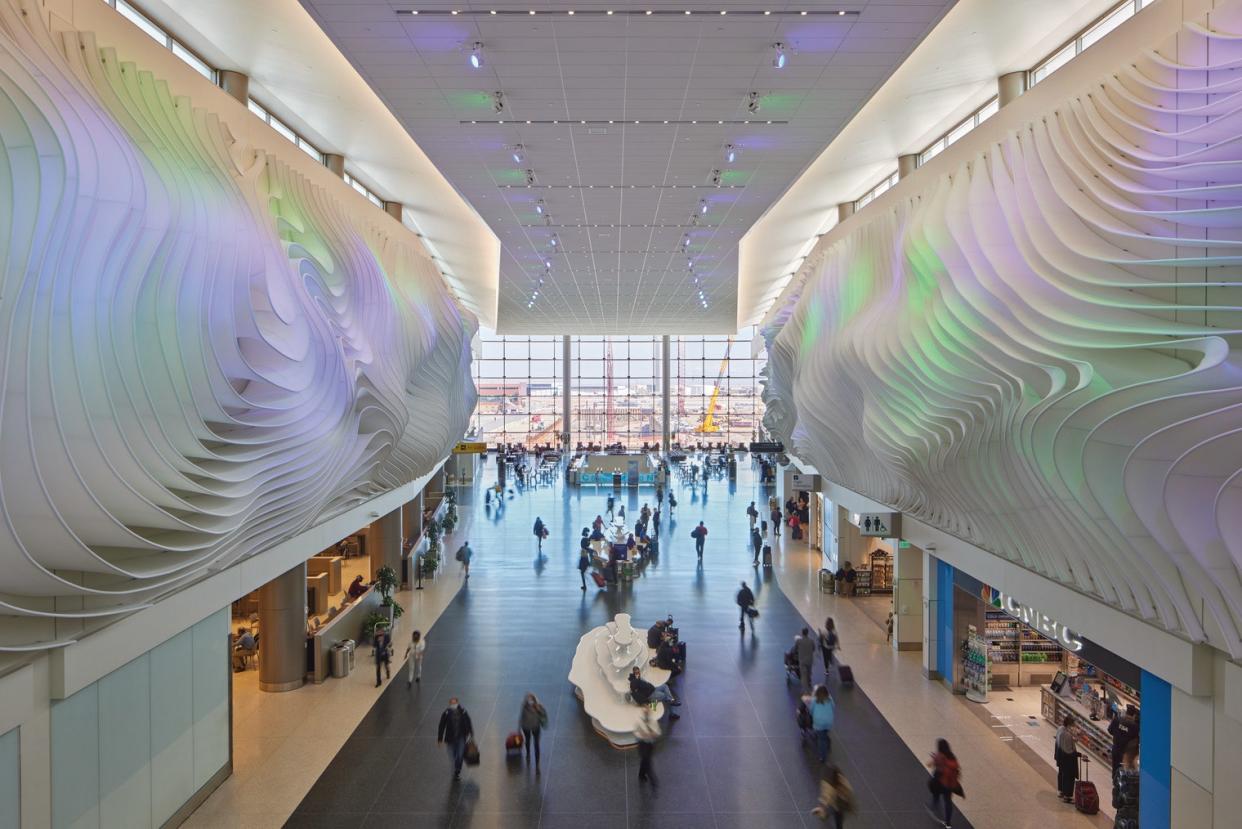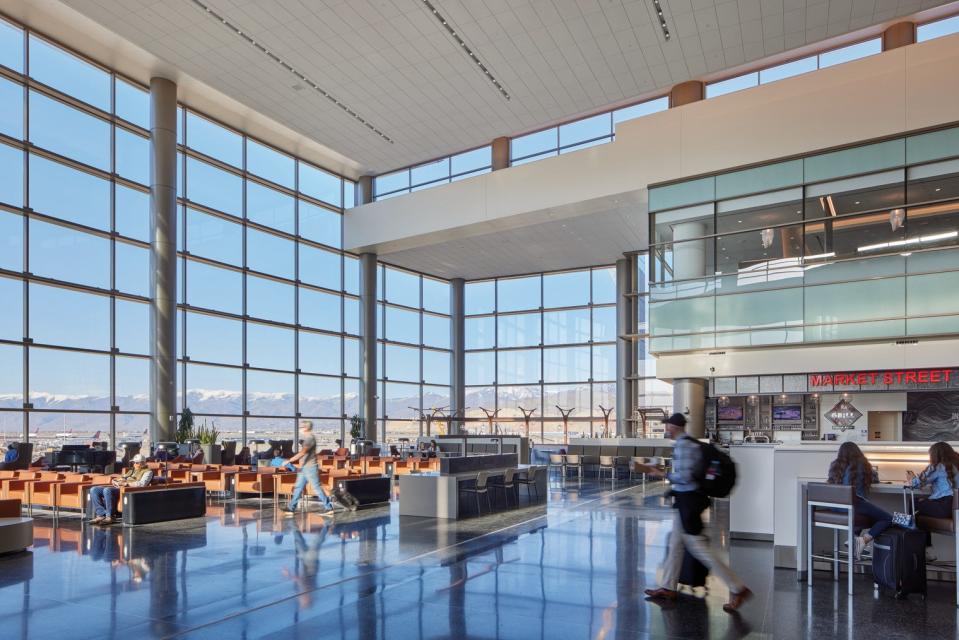Salt Lake City’s New Airport Is Art-Filled, Multi-Sensorial, and Designed for the Future

Bruce Damonte/HOK
Customary travel wisdom says spending a few hours in a city’s airport doesn’t “count” as experiencing the place itself. That’s because American airports today are often viewed as transitory hubs removed from space and time—like a mall or suburban highway strip—visit one and you could be anywhere in the US.
But the airports of the future will be infused with local business, art, and food that let you know exactly where you are in the world upon arrival or departure. That’s what the Salt Lake City airport (SLC) has aimed to do through a $5.1 billion rebuild that’s been unveiled in phases over the past few years, to be completed in 2026.
Known as the New SLC, the project is considered the first new US hub airport built in the 21st Century—and this fall is its grand reveal. Come October, the airport will unveil “Phase 3,” which includes a central tunnel connecting concourses A & B (the “River Tunnel”), a new multi-gate expansion, a highly anticipated new greeting room, more impressive art installations, and a mini plaza with retail and food and beverage concessions (with a handful of local brands, like Salt Lake City’s Weller Book Works). Next up—under construction until the airport’s final 2026 completion—SLC will be revealing more gates with loading bridges.
We got a sneak peek of Phase 3 of the New SLC and the design is modern, sensorial, and steeped in a sense of place, from the artful touches of copper paint colors (Utah’s known for copper mining), to flourishes of sage (which grows all over the state) in its terrazzo floors, to the upcoming tunnel installation simulating the flow of a river flowing through a canyon.
“When you design a hub airport, the focus is often on efficiency over beauty. But who wants to be in a nameless, faceless airport?" Matt Needham, Director of Aviation + Transportation at HOK (the architecture firm responsible for SLC), tells Condé Nast Traveler. “Our goal in Salt Lake City was to create a distinctive space that was of the place.”

Not only were they able to bring the beauty of the state of Utah to the airport, and right inside the facility—they have also worked with creatives to create an iconic, design-led, art-filled, eco-conscious airport. Since 2015, the Salt Lake City Department of Airports have partnered with artist Gordon Huether for the airport’s Terminal Redevelopment Program; he created the comprehensive art master plan including numerous large scale art installations, a curation of the airport’s art collection, plus a facilitation of future public art opportunities.
“I wanted to give something to everyone: whether you’re a pilot, working in the restaurants on site, visiting the state, or just trying to get somewhere without leaving the terminal,” Huether says. “I wanted it to feel like one creative force that flows throughout.”
This is where the immersive “River Tunnel” art installation, a 1,000-foot-long tunnel connecting concourses A & B, comes in. The membrane sculpture is made of an aluminum frame wrapped with a Tweave Duratech 570C fabric material to create individual fins, and enclosed with a zipper along the spine. “We have LED lighting projected onto the fins in tones of blue. And my favorite part is the curated travel-themed music playlist that will play 100 songs through 150 high-quality speakers—you will never hear the same song twice,” Huether says.

Last year, the airport opened its monumental gateway installation by Huether, titled “The Peaks.” Made from withering steel, it’s inspired by the Wasatch Mountains, and greets travelers on the outside as they arrive at SLC. Now, the airport has started to reveal all of the art displayed throughout the building—even in the bathrooms. “On one end we have ‘The Canyon,’ taking inspiration from the surrounding landscape, which is a 400 ft. long by 22 ft. tall tensile membrane fins made of aluminum tubing and composite fabric,” adds Huether. “We also have ‘The Falls’ which is a suspended sculpture cascading six stories using colorful light-sensitive dichroic glass panels. Plus a whimsy wall featuring a selection of local artists and international artists.”
But an airport can’t just be pretty to look at, of course—it has to handle massive quantities of travelers and their location-specific needs. The old SLC airport was built to accommodate 10 million passengers per year (prior to the pandemic, it was accommodating more than 26 million passengers annually). In 2023, SLC recorded nearly 27 million annual passengers, and the new SLC is being built to accommodate 34 million passengers per year. And with 10 major ski resorts within an hour's drive of SLC, it’s safe to assume a large portion of travelers are going straight from the airport to the slopes.
“For golf and snow sports we created ease for people to get themselves and their equipment in and out as fast as possible,” Bill Wyatt, the Executive Director of the Salt Lake City Department of Airports, tells Traveler. “We incorporated ski drops; plus, our rental cars are right at the terminal.”

Sustainability is another core tenant of the New SLC airport, one of a few airports in the US to achieve LEED Gold certification. Initiatives include “high-performance glazing, daylighting, energy-efficient mechanical and lighting systems, waste minimization, water conservation, renewable energy implementation, and an efficient configuration of terminal and gate locations that reduces fuel use and aircraft emissions,” says Michael P. Williams, the Project Director at SLC.
The New SLC features a new Delta Sky Club in Concourse A, coupled with a second Delta Sky Club being built in Concourse B, a United lounge, and a common-use lounge. But one of the most unique things at SLC is the Senator Jake Garn Greeting Room. Created as a pre-security lounge space for up to 400 guests, this is where family members—traditionally gathering for returning missionaries from The Church of Jesus Christ of Latter-day Saints and military personnel–can reunite and leisurely hang out on low-slung chairs or funky benches. SLC also included art here, a reimagination of the old airport’s “World Map” reproduced in hanging glass. Whether you’re coming or going, a respite right here by the homey stone fireplace might be exactly what you need.
Originally Appeared on Condé Nast Traveler
The Latest Travel News and Advice
Want to be the first to know? Sign up to our newsletters for travel inspiration and tips
Cruise Etiquette: How To Get the Most Out of Shore Excursions
This Airport Lounge Was Just Voted Best in the World—Here's What It's Like Inside
This New Multi-Nation Visa Will Grant Tourists Entry to Six Gulf Countries


